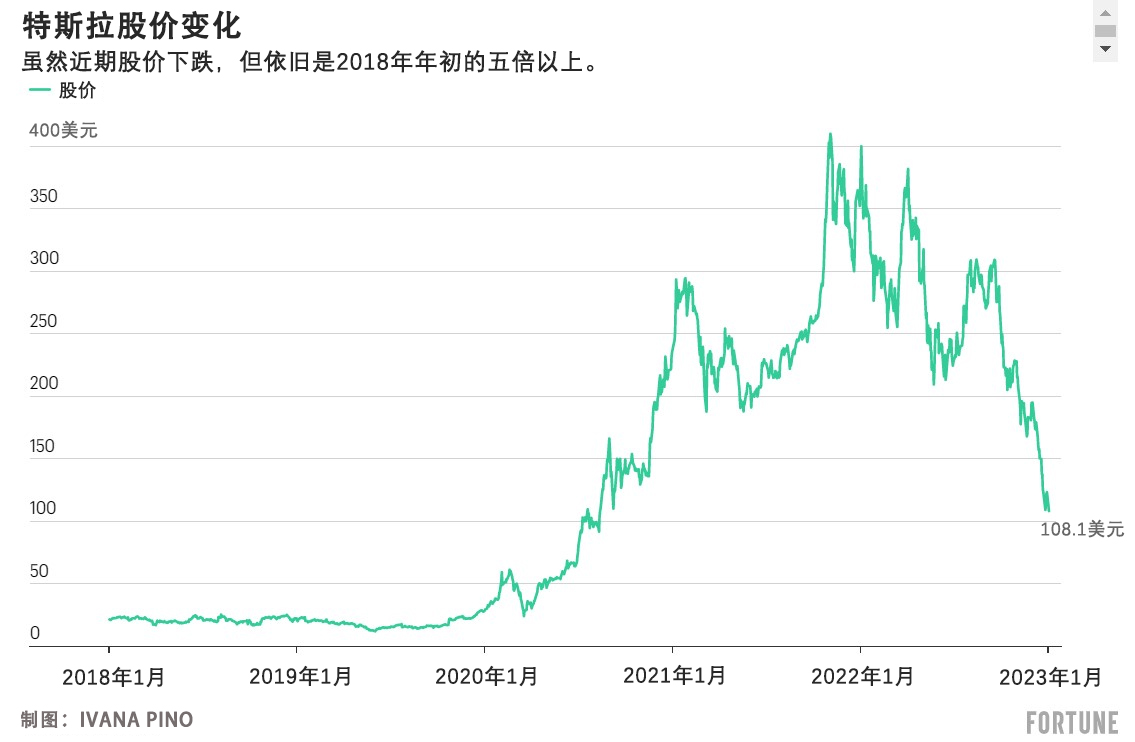
特斯拉(Tesla)的股價持續(xù)下跌,1月3日下跌13%,,一天前該電動汽車公司剛剛公布了2022年第四季度的汽車產(chǎn)量和交貨量,。
2022年最后三個月,特斯拉的汽車銷量僅為405,000輛,,低于華爾街分析師預估的420,000輛,。
但盡管經(jīng)歷了大幅下跌,特斯拉股價自上市以來依舊經(jīng)歷了大幅上漲,。
2010年,,特斯拉上市時每股股價為17美元,2021年11月達到史上最高的每股超過400美元,。特斯拉目前市值超過3,000億美元,,被公認為全球最有價值的汽車公司之一。

五年前投資1,000美元目前的價值
對于早期投資特斯拉股票的股東來說,,短期股價下跌并不會抹去他們的長期收益,。
2018年1月2日,特斯拉股票的交易價格為每股21.37美元,。截至2023年1月3日,,每股交易價格為108.10美元,漲幅高達405%,。所以,,五年前在特斯拉投資1,000美元,現(xiàn)在價值4,973美元,,利潤高達3,973美元,。
即使你沒有在五年前投資,而是選擇利用疫情刺激補貼或推遲償還的學生貸款,,在2020年5月1日股價46.75美元時進行投資,,這筆投資現(xiàn)在已經(jīng)上漲了80%,總價值達到2,270美元,。
沒有人能夠保證可以確定市場時機,,并且在正確的時間投資某一只股票,,從而大賺一筆,。股市總是變化莫測,令人難以捉摸,,你無法預測自己投資的股票對于世界大事,、自然災害或經(jīng)濟下滑會產(chǎn)生什么反應,。通過一只股票以往的表現(xiàn),并不總是能夠預測出它未來的漲跌情況,。
事實上,,得益于復利的存在,你投資的時間越長,,你的資金就有更多時間上漲,,并為你創(chuàng)造效益。
在投資一家公司之前需要考慮哪些因素
如果你考慮投資特斯拉或你喜歡的其他股票,,首先應該進行多個方面的考慮,。
1. 投資規(guī)模不要超過你可以安心接受的金額。要確定自己能夠投資的金額,,最終取決于你可以安心接受股市占用多少資金,,以及一旦出現(xiàn)不利變化,你能夠承受多少損失,。專家們建議的一條基本原則是,,投資金額應該在稅收后入的15%至25%之間。當然,,具體比例因人而異,,你應該定期進行重新評估,以確定該策略是否適合自己,,并在財務狀況發(fā)生變化時進行調(diào)整,。Integrated Financial Group的理財顧問保羅·皮勒表示:“投入股市的資金占比,取決于你在多久之后才需要動用這筆資金,,以及你對股價波動的容忍度,。期限越長,容忍度越高,,投入股市的資金比例就可以更高,。反之亦然?!?/p>
2. 不要試圖以歷史表現(xiàn)預測未來收益,。一筆投資目前或曾經(jīng)表現(xiàn)出色,并不意味著你未來一定能夠大賺一筆,。在選擇投資對象時,,應該進行調(diào)研,研究公司的歷史股價波動,、收入和預測情況,,但切記,在確定投資對象和投資金額時,,必須以自己的風險承受能力,、時間期限和投資目標為依據(jù),。
3. 不要用全部資金投資一家公司的股票。可以通過各種方式投資多家更年輕的公司,,而不是把全部資金只投入某一家公司,。皮勒說:“全球性的多樣化指數(shù)基金組合,默認會持有一些新公司的股票,,因此按照這個標準,,投資者應該持有一些更年輕的公司的股票。但極少有人應該將投資組合的絕大部分,,與在新公司的直接持股掛鉤,。”(財富中文網(wǎng))
譯者:劉進龍
審校:汪皓
特斯拉(Tesla)的股價持續(xù)下跌,,1月3日下跌13%,,一天前該電動汽車公司剛剛公布了2022年第四季度的汽車產(chǎn)量和交貨量。
2022年最后三個月,,特斯拉的汽車銷量僅為405,000輛,,低于華爾街分析師預估的420,000輛。
但盡管經(jīng)歷了大幅下跌,,特斯拉股價自上市以來依舊經(jīng)歷了大幅上漲,。
2010年,特斯拉上市時每股股價為17美元,,2021年11月達到史上最高的每股超過400美元,。特斯拉目前市值超過3,000億美元,被公認為全球最有價值的汽車公司之一,。
特斯拉股價變化
雖然近期股價下跌,,但依舊是2018年年初的五倍以上。
股價
400美元
108.1美元
2018年1月 2019年1月 2020年1月 2021年1月 2022年1月 2023年1月
制圖:IVANA PINO
五年前投資1,000美元目前的價值
對于早期投資特斯拉股票的股東來說,,短期股價下跌并不會抹去他們的長期收益,。
2018年1月2日,特斯拉股票的交易價格為每股21.37美元,。截至2023年1月3日,,每股交易價格為108.10美元,漲幅高達405%,。所以,,五年前在特斯拉投資1,000美元,現(xiàn)在價值4,973美元,,利潤高達3,973美元,。
即使你沒有在五年前投資,而是選擇利用疫情刺激補貼或推遲償還的學生貸款,在2020年5月1日股價46.75美元時進行投資,,這筆投資現(xiàn)在已經(jīng)上漲了80%,總價值達到2,270美元,。
沒有人能夠保證可以確定市場時機,,并且在正確的時間投資某一只股票,從而大賺一筆,。股市總是變化莫測,,令人難以捉摸,你無法預測自己投資的股票對于世界大事,、自然災害或經(jīng)濟下滑會產(chǎn)生什么反應,。通過一只股票以往的表現(xiàn),并不總是能夠預測出它未來的漲跌情況,。
事實上,,得益于復利的存在,你投資的時間越長,,你的資金就有更多時間上漲,,并為你創(chuàng)造效益。
在投資一家公司之前需要考慮哪些因素
如果你考慮投資特斯拉或你喜歡的其他股票,,首先應該進行多個方面的考慮,。
1. 投資規(guī)模不要超過你可以安心接受的金額。要確定自己能夠投資的金額,,最終取決于你可以安心接受股市占用多少資金,,以及一旦出現(xiàn)不利變化,你能夠承受多少損失,。專家們建議的一條基本原則是,,投資金額應該在稅收后入的15%至25%之間。當然,,具體比例因人而異,,你應該定期進行重新評估,以確定該策略是否適合自己,,并在財務狀況發(fā)生變化時進行調(diào)整,。Integrated Financial Group的理財顧問保羅·皮勒表示:“投入股市的資金占比,取決于你在多久之后才需要動用這筆資金,,以及你對股價波動的容忍度,。期限越長,容忍度越高,,投入股市的資金比例就可以更高,。反之亦然。”
2. 不要試圖以歷史表現(xiàn)預測未來收益,。一筆投資目前或曾經(jīng)表現(xiàn)出色,,并不意味著你未來一定能夠大賺一筆。在選擇投資對象時,,應該進行調(diào)研,,研究公司的歷史股價波動、收入和預測情況,,但切記,,在確定投資對象和投資金額時,必須以自己的風險承受能力,、時間期限和投資目標為依據(jù),。
3. 不要用全部資金投資一家公司的股票。可以通過各種方式投資多家更年輕的公司,,而不是把全部資金只投入某一家公司,。皮勒說:“全球性的多樣化指數(shù)基金組合,默認會持有一些新公司的股票,,因此按照這個標準,,投資者應該持有一些更年輕的公司的股票。但極少有人應該將投資組合的絕大部分,,與在新公司的直接持股掛鉤,。”(財富中文網(wǎng))
譯者:劉進龍
審校:汪皓
Tesla stocks have continued to fall, declining 13% on January 3, a day after the electric auto maker reported vehicle production and delivery numbers for the fourth-quarter of 2022.
The company sold just 405,000 cars during the final three months of 2022, falling short of Wall Street analysts’ estimate of 420,000.
Still, even with such significant losses, Tesla has seen tremendous growth since its inception.
The company first went public in 2010 at $17 per share and hit just over $400 per share at its all-time high in November, 2021. Worth well over $300 billion, Tesla is recognized as one of the most valuable car companies in the world.
How much you’d have if you’d invested $1,000 five years ago
For shareholders who got in on Tesla stock early, these short-term declines don’t erase their long-term gains.
On January 2, 2018, one share of Tesla was trading at $21.37. As of January 3, 2023, one share was trading at $108.10, which is a 405% increase. So if you’d invested $1,000 five years ago, you’d have $4,973 today, which is a $3,973 profit.
Even if you hadn’t invested five years ago and instead you opted to use your stimulus check or postponed student loan payment to invest on May 1, 2020 when share prices hit $46.75, your investment would be up by almost 80% for a total value of $2,270.
Timing the market and trying to get in on a certain stock at the right time isn’t guaranteed to lead to a major fortune. The stock market is wildly unpredictable and there’s no telling how your investments will respond to world events, natural disasters, or economic downturns. Past performance isn’t always indicative of how a certain stock will increase or decrease over time.
What is true is that the longer you’re invested, the more time your money has to grow and work for you thanks to the magic of compound interest.
What to consider before investing in a certain company
If you’re considering investing in Tesla or another company you’re passionate about getting behind there are a few considerations you should make.
1. Never invest more than you’re comfortable with. Knowing how much to invest will ultimately depend on how much you’re comfortable tying up in the market and how much you’re okay with losing if things don’t work out in your favor. As a general rule, experts suggest investing between 15% to 25% of your after-tax income. Of course, this will vary from person to person and you should make it a point to reevaluate periodically to make sure this strategy still works for you and adjust if your financial circumstances have changed. “The percentage of that going into stocks is determined by the length of time before the money is needed and tolerance for volatility,” says Paul Peeler, financial advisor at Integrated Financial Group. “The longer the time frame and the higher the tolerance, a higher percentage can go into stocks. And vice-versa.”
2. Don’t try to use past performance to dictate future earnings. Just because an investment is doing well or has done well in the past doesn’t mean that you stand to win big in the future. When choosing a stock to invest in, you should do your research and look into a company’s price history, revenue, and projections, but keep in mind that your decision about what to invest in and how much should be based on your risk tolerance, time horizon, and investment goals.
3. You don’t have to tie all of your money up in one company’s stock. There are ways to gain exposure to investments in a number of younger companies without putting all of your money behind a certain one. “A globally diversified portfolio of index funds will own some young companies by default, so by that criteria everyone should own some younger companies,” says Peeler. “But very few people should have a substantial portion of their investment mix tied up in direct shares of young companies.”






